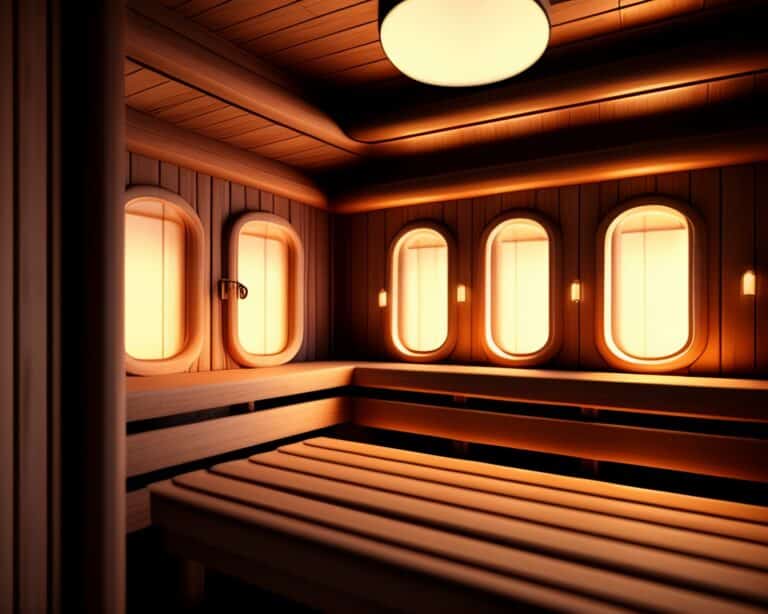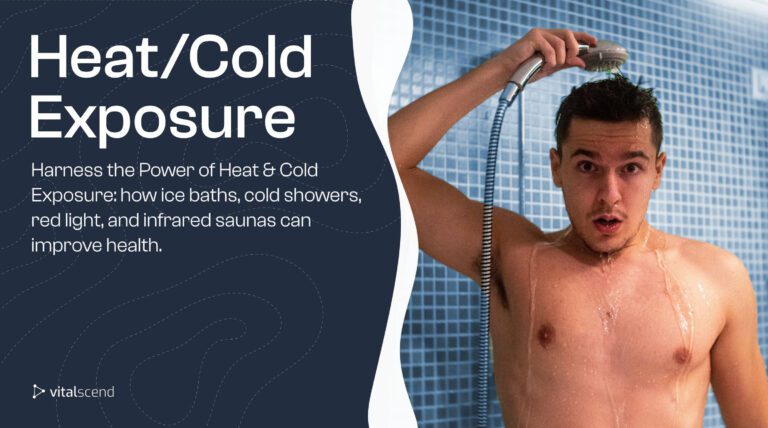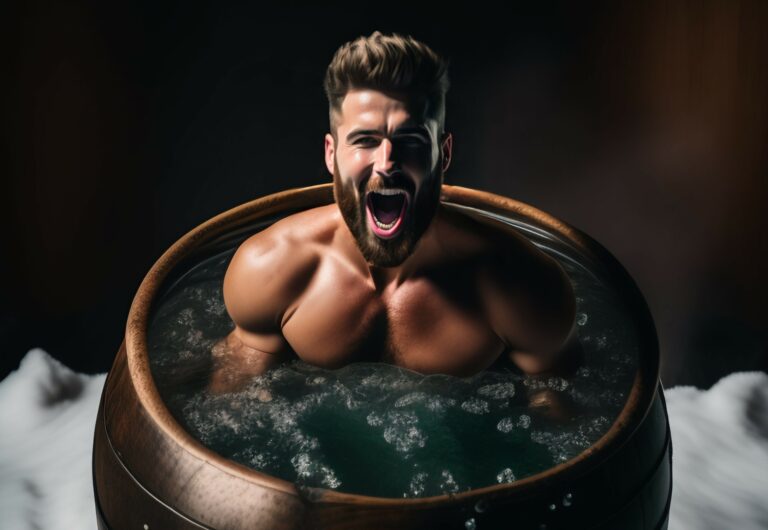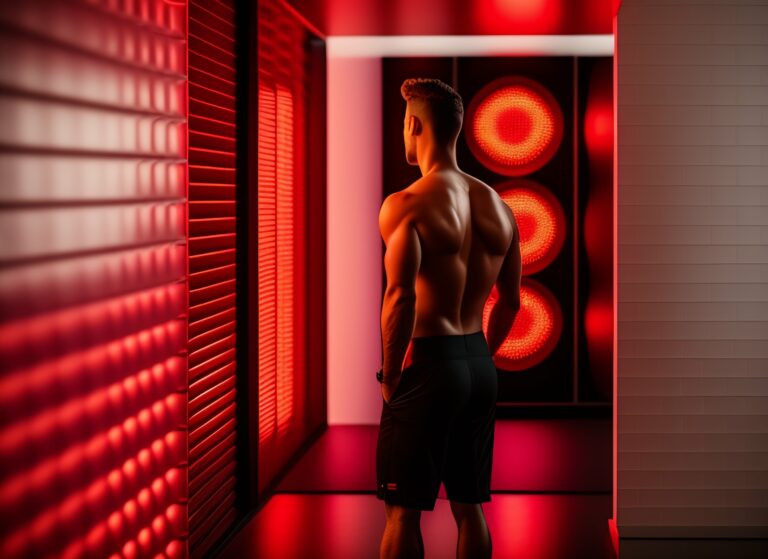7 Benefits of Cold Exposure: Fat-Loss, Immunity & Recovery
The rise of the Wim Hof method propelled cold exposure, so much, that it’s the secret weapon of many athletes, entrepreneurs, and biohackers. Science really started taking a deep look at its potential benefits on fat loss, recovery, and longevity.
And rightfully so. It can strengthen the nerves, boost immunity and even improve our mood. Whether you’re doing a cold plunge after a heavy workout, or you’re into cryotherapy, cold showers, or cold exposure – this one is for you.
Hormesis: Hormetic Stress and Adaptation
Cold exposure stimulates hormesis, a process that leads to adaptation. Cold is a stressor on its own. Provided it’s used in an optimal setting with strategic application – it may improve health and performance.
Hormesis revolves around the idea that exposing an organism to a certain stressor makes it more capable of fighting back. Cold exposure is thought to unlock our defense mechanisms – like immune function, thus making us more robust and resilient. (1)
In scientific terms, hormesis is the biphasic dose-response stressor that causes a favorable adaptation, the so-called hormetic adaptation.
A natural biological process that makes humans adapt to environmental changes – so we can defend and live longer.
Fun Fact
Once exposed to cold, the body goes through a myriad of physiological adaptations. If done correctly it can stimulate regeneration – replacing damaged cells, improving repair quality, and fighting oxidative stress.
The Rise of Cold Exposure
Cold exposure isn’t a new thing. Texts that highlight the use of cold exposure date back to 3.500 B.C.E, and it doesn’t end there. Hippocrates, the Greek physician used to snow and ice to stop bleeding, and Galen invented the cold cream for medical use.
The real rise of cold exposure in the 21 century is led by the Wim Hof Method. The superhuman things Wim could do led scientists to a new discovery. From controlling the brain with a breathing exercise to reducing inflammation, pain, and improving mood, cold did it all. That’s a nice slogan. Biology textbooks had to be rewritten, for good.
Nowadays, cold exposure is a huge trend among not just athletes, but health-conscious people. We’ve seen the power it carries in the realm of fat loss and metabolic adaptation, so much so that it’s standard practice for some.
What is the Wim Hof Method?
The Wim Hof method is one of the fastest-growing extreme cold exposure techniques out there, created by Wim Hof, the extreme Dutch athlete. It combines three pillars breathing, cold exposure, and meditation, aiming at improving immunity, mental clarity, and reducing stress.
What are the benefits of cold exposure for muscle recovery?
After exercise, exposing oneself to cold, such as by taking an ice bath, can help reduce muscle swelling and inflammation. Less muscular discomfort and a quicker recovery time may result from this. It’s important to note that if muscle growth is the key focus, cold exposure isn’t your friend, as the muscle needs the inflammatory response to grow.
Can cold exposure help with weight loss?
Yes, cold exposure increases shivering which stimulates the production of brown fat, which is more metabolically active than white fat. It can also boost metabolic rate and burn more calories as the body tries to produce more heat.
Physiological Adaptations to Cold
Once the cold hits you numerous reactions are happening. You’d notice your breath deepens like a yoga guru. Your heart rate and breathing speed up. Noradrenaline and epinephrine shoot up. It’s a blast.
Skin neurons, upon detection of cold, stimulate thermogenesis. This stimulates shivering, blood vessels constrict, we start tapping into fat stores to produce energy, and heat is evaporating – all to warm the body back up.
Strategic application of cold is necessary to stimulate healthy adaptation. Such short stressors of cold, with a proper recovery period, can lead to a more robust and resilient body.
How Cold is Cold Enough?
How cold the water or air should be during cold exposure is a very individual question. It depends on brown fat stores, cold adaptation, sex, timing, heat-generation capabilities, etc.
- Cold showers are by definition around 60-70 Fahrenheit or 15.5-21 °C.
- Cold exposure to air of around 15-19 °C makes up the bulk of the research emphasized in this article.
- Ice baths are around 12-15 °C, while the coldest water immersion (very short) is at 4 °C.
Adaptation is key. At first one can start with cool water that just feels refreshing before doing a real cold shower. It shouldn’t be shockingly cold to a level one can’t stay in safely. The colder it is, the shorter the exposure should be.
Disclaimer: Cold exposure, especially longer can lead to hypothermia and fatal injuries if done incorrectly. The shock of a cold can be too much for some people, leading to unwanted health issues or events. Always consult your doctor before trying any cold exposure method, and get proper guidance from an expert.

7 Benefits of Cold Exposure
The obvious ones are recovery and immunity boost. But let’s see what else cold has to offer, how it works on a deeper level, and give it some context.

1. Circulation and Heart Health
Cold is naturally anti-inflammatory. It fights inflammation, which is good news for heart health and longevity. How about circulation?
Circulation is about transferring more oxygenated blood to tissues. Two things to learn. Vasodilatation is increasing blood vessel diameter, meaning higher blood flow. Vasoconstriction is the opposite.
As soon as the cold hits you, the skin neurons send signals that cause vasoconstriction – as seen with the local cooling of a human finger. Afterward, the adaptation to that is improved blood flow, or as my nerds like it – cold-induced vasodilation (CIVD). (2)
In another area, your brown fat (BAT) cold exposure does the opposite. Even acutely it increases an enzyme called eNOS, which increases Nitric Oxide production. This causes vasodilation, increasing blood flow – in brown fat. (3)
The third cold weapon is increasing adiponectin levels – a cardioprotective protein. Low levels are associated with obesity and CVD diseases, so cold exposure may counteract these effects and inhibit pro-inflammatory pathways. (4)
Conclusion
Acutely cold exposure can reduce circulation peripherally, leading to improved blood flow later on. It improves circulation in brown fat and increases adiponectin levels, a potent cardioprotective protein.
2. Fat-Loss and Weight Loss
Adaptations to cold can be so powerful in terms of fat loss and insulin response, that scientists started to look for ways to practically apply it to obesity.
By causing you to shiver, cold water boosts metabolism. So much so, that in 14°C cold water immersion metabolic rate shot up by 350%. (5)
Besides all that gorgeous muscle you have, we’re made of white and brown fat as well.
- White fat of WAT (adipose tissue) stores excess energy as triglycerides. It’s less metabolically active and high levels are linked to poor cardiometabolic health.
- Brown fat or BAT is a more metabolically active tissue that helps produce heat, to warm the body up. (6)
More brown and less white fat is what we aim for. Why? Brown fat actively burns calories, improves the metabolism of lipids and insulin sensitivity. Cold exposure causes browning of WAT, as white fat cells are plastic enough to differentiate into beige fat. (6)
It’s shivering that burns calories short-term. But it’s the increase of BAT to WAT that makes you a more metabolically efficient calorie burner.
Numerous studies have shown this to be the main mechanism:
- Exposure to 16∼19°C increased energy expenditure and BAT activity superior to exposure at 24°C. (7)
- Increase in brown adipose tissue in the cold-exposure group. (8)
- Sleeping at cooler 19°C temperatures increased brown fat volume by 42% and metabolic activity by 10%, compared to 24°C (9)
Conclusion
The main mechanism cold accelerates fat loss is by the turnover of white to brown fat. BAT is a more metabolically active fat that burns calories to produce heat.
3. Immune System Boost
The list wouldn’t be final without highlighting the most exciting breakthrough the Wim Hof Method brought. Yap, cold adaptation boosts immune function.
A single cold water immersion at 14°C had only a minor effect on the immunity of young athletic men. But as they adapted to it, doing it 3x weekly for 6 weeks – monocytes, lymphocytes, and TNF-alpha increased. (10)
See, the immune system needs these cells which work to recognize, transport, and produce antibodies to kill viruses, and bacteria and fight disease.
Cold-adapted humans had higher IL-6 levels an anti-inflammatory cytokine, and higher levels of T lymphocytes, T helper cells, activated B and T lymphocytes, and T suppressor cells. I mean c’mon, that’s impressive. (10) (11)
Cold showers for 30, 60, or 90 seconds led to a significant reduction in absence from work due to sickness, by 29% compared to the control group. (12)
Conclusion
Adapting to cold helps boost immune function. It makes the body more resilient to stressors like cold, by increasing the cells that fight bacteria and diseases.
4. Insulin Sensitivity
Insulin sensitivity is about the proper recognition and transport of glucose to tissues. Without it, we have poor blood glucose control leading to obesity, diabetes, and CVD.
Research shows cold exposure can improve insulin sensitivity. In 8 people with T2 diabetes, only 10 days of cold acclimation at 14-15 °C improved insulin sensitivity by 43%. (13)
Adaptations to cold can improve GLUT4 function – the most important glucose transporters, as well as increase glucose uptake in brown fat.
Just like exercise, cold can improve insulin sensitivity as well. It burns calories, utilizing more fats and glucose for it. Even in healthy individuals both glucose uptake and insulin sensitivity improved by ∼20%. (14)
The mechanisms involve better glucose uptake and tolerance, which is logical as energy expenditure is increased. (15) Cold is like an exercise in that regard.
Conclusion
Cold works similarly to exercise. To produce heat we burn calories for which we use fats and glucose. This can lower fasting glucose levels, but also improve insulin sensitivity – leading to a greater metabolic function.
5. Muscle Recovery
You’ve probably seen athletes enjoying a nice cold plunge after a workout. But why? Cold reduces inflammation which is what’s increased in the muscle after a workout.
However, a critique to jumping in the cold right after a workout is – you don’t want to reduce the inflammatory response. That’s what will cause the muscle to grow, adapt, and regenerate.
Theories of how cold improves muscle recovery has to do with pain, edema and inflammation reduction, less muscle spasm, and improved blood flow. (16)
Ice baths at 12-15°C, commonly used by athletes may help flush out waste and toxic by-products like lactic acid. (17) It seems that baths aren’t that bad huh?
Numerous studies show the potent effects of whole-body cold exposure.
- Reduced glutathione, a potent antioxidant increased (18)
- Cori cycle was activated, reducing pro-inflammatory IL1b and IL6 levels (19)
Conclusion
Cold exposure can reduce lactate, improve blood flow, and decrease inflammation. However, jumping in an ice bath right after a workout is probably not the best idea. Let the muscle naturally regenerate to become stronger, before applying cold.
6. Mood and Depression
Cold showers can stimulate some good-feeling hormones, so-called endorphins. But we’re not talking about serotonin. Actually, the moment the cold hits you it activates the sympathetic nervous system. These electric impulses can have an anti-depressive effect. (20)
Hormones like noradrenaline and epinephrine shoot up. So you’re not kind of happy, but you’re alert and activated. Something different from being sleepy and lethargic, common for depression.
Cold water immersion at 14 °C increased noradrenaline by 530% and dopamine by 250%. Dopamine is one of the main hormones which plays a role in motivation, satisfaction, and behavior. (21)
The combination of breathing, meditation, and cold exposure evolves beyond just simple mood boosts. You can reduce panic receptor activity and tell the little monkey brain to shut up.
Conclusion
Cold exposure combined with breathing and meditation can train your mental resilience and improve self-awareness. Hormone-wise, cold activates you, releasing stress hormones like noradrenaline and endorphins like dopamine, with an anti-depressive effect.
7. Cognitive Performance
Surprised to find that mental performance suffers during a cold exposure session. Yes. In 18 studies, 8 used cold air exposure, and 10 cold water immersion. Cold impaired attention, memory, and executive function. (22) Another study showed similar effects, as cold reduced working memory, executive function declined and reaction speed was worse. (23)
These drops in cognitive performance are acute, due to attention shifts. The body focuses on fighting the cold, and generating more heat is the main goal.
But the cold application can increase alertness, (24) stimulate the sympathetic nervous system (25) and increase norepinephrine, an important memory modulator. (26)
After these three, everyone is more focused and awake, ready to tackle a cognitively demanding task. Plus, the release of endorphins makes us feel good, powerful, and resilient.
Conclusion
Acutely cold exposure impairs cognitive performance. But due to its stimulatory effects on the sympathetic NS, it increases alertness and energy. Plus, cold boosts endorphins, hence why we feel so good afterward.
Longevity: Do Cold-Adapted Live Longer?
The notion that cold adaptation can enhance longevity and extend one’s lifespan started in the lab. Most species can live longer in the cold as fewer bacteria develop and the immune system is enhanced.
Part of that thinking involves the theory of aging, associated with oxidative stress. It works under the premise that higher temperatures boost metabolic rate, thus producing more ROS or free radicals which cause DNA damage, thus facilitating aging.
On average, people in colder climates tend to live a bit longer. Part of that is genetics, as cold can turn on certain genes that make us more resilient. In hot environments, heat stress and bacteria growth is increased. In general, many cold-adapted people live more outdoorsy life, filled with hiking, breathing cleaner air, and living a less stressful life in the mountains.
Types of Cold Exposure
Cold exposure can be done in various ways. The most common ones include:
- cold air exposure (<0 °C) or cryotherapy (-85 to -145 °C)
- cold showers – showers with water at 10-15 °C (or 50-60 °F)
- ice baths – bath with water at 10-15 °C with additional ice
Some more advanced practitioners of cold exposure may also take an ice dive or a longer hike in the snow, with minimal clothing which can be quite dangerous.
Conclusion
- Who Does Cold Exposure? Cold exposure was greatly accelerated by the Wim Hof approach, as now it is the go-to strategy for many entrepreneurs, athletes, and biohackers.
- Hormetic Stress: Exposure to cold promotes hormesis, which facilitates adaptability. The cold is a stressor itself, to whom we can adapt. It might enhance health and performance if used strategically and in an ideal dose.
- Acute Shock: Whenever the cold hits your body, various reactions happen. Your breathing is deeper, just like a yoga master. Respiration and heart rate increase. Epinephrine and noradrenaline surge.
- Physiological Adaptations: Skin neurons trigger thermogenesis when they sense cold. Shivering is induced, blood vessels close, and energy production from fat stores increases, all so that the body can warm up to sustain vital temperatures.
- How Cold? By definition, cold showers are cold if between 60-70 Fahrenheit, or 15.5 and 21 Celsius. The majority of the research studies exposure to cold air of 15-19 °C. The coolest water immersion (which lasts just a very brief time) is at 4 °C, whereas ice baths are at 12–15 °C.
- 7 Benefits of Cold Exposure: Improve Heart Health and Circulation, Fat-Loss and Weight Loss, Immune System Boost, Better Insulin Sensitivity, Faster Muscle Recovery, Balance Mood, and Boost Cognitive Function.








